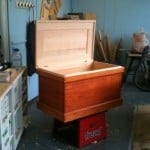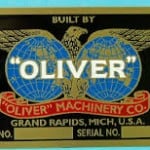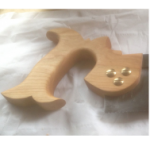Planing long, wide, thin stock
Welcome! / Forums / General Woodworking Discussions / Planing long, wide, thin stock
- This topic has 16 replies, 13 voices, and was last updated 11 years ago by
 dmarshall83.
dmarshall83.
-
AuthorPosts
-
 23 May 2013 at 10:32 am #12395
23 May 2013 at 10:32 am #12395Hi guys,
I’m building a small set of shelves from 3/4″ thick stock (redwood). The side pieces are 24″ long, 6 3/4″ wide and 3/4″ thick. I find it impossible to hold them securely enough in the vice so that they don’t belly or move when planing the faces.
I’ve taken to putting them on the bench top, butted up against a couple of dogs, but they still move because there’s no stop at the other end. I’ve used clamps to hold one end while I plane the other (similar to how holdfasts would be used) but when you’ve got seven pieces to plane on both sides, it gets annoying having to keep switching the clamp around, and the clamp can get in the way.
The next thing I’m going to try is setting up two 1/4 or 3/8″ thick strips of wood as planing stops, clamped in place across the whole bench top, one at each end of the work. It should hold the piece well enough so that it doesn’t move too much and pieces can be swapped in and out without having to adjust the stops.
This is not particularly thin stock, either. I’m going to make a couple of drawers to go at the bottom of the shelf unit and they’ll be made from 1/2″ or thinner wood that will belly or move much more than 3/4″ thick stuff, and need shorter planing stops/dogs.
How do you guys hold timber like this in place when planing it? I’m finding myself entertaining the idea of installing a tail vice and boring a few more dog holes!
Thanks in advance,
George.
 23 May 2013 at 10:53 am #12396
23 May 2013 at 10:53 am #12396hi george just a quick suggestion have you tried using the rubberised matting that Paul used in the vice jaws it may help alongside your dogs .

Have you considered the Veritas pups?
http://www.leevalley.com/en/Wood/page.aspx?p=62720&cat=1,41637,41645&ap=1
 23 May 2013 at 2:22 pm #12413
23 May 2013 at 2:22 pm #12413Thanks for the input, guys.
@edfly I’ve used it before but there’s a fair amount of give in the shelf liner. When you push down on the plane you can feel the piece move, which makes things awkward.
@ken That’s the setup I’m going to try next. An ideal solution wouldn’t use clamps but I think that may be the best way without spending money and/or making any alterations to the bench.
@richardleon I’ve seen those but I can get a vintage tail vice for the same or less cash over here. I think if I was going to spend money to solve the problem, a tail vice would be my preferred option.George.

I have the Veritas twin vice which I thought was one of the best you could get at the time. I NEVER use it. The problem with tail vices and perhaps this one in particular is because of the weight, when they are open they tend to sag so your board is not held flat. It also takes ages to open and close it.
I think there are much better options to clamp a board then tail vices. The Festool clamping elements are amazing although they work in 20mm holes and most people drill 3/4″ holes in their benches.
In fact, this post has spurred me into action and I am going to try to sell my Veritas vice in the local classifieds shortly!

George,
Kens’ solution works well and you can adjust the angle of attack easily.
I use Ian Kirbys’ planning stop and the Inset vice from Lee Valley.
Also, there’s Pauls approach.
http://paulsellers.com/2013/03/are-dogs-a-mans-best-friend/
CraigAttachments:
You must be logged in to view attached files.23 May 2013 at 3:45 pm #12423Take this with a grain of salt since I just finished my workbench a couple of weeks ago you can see it on the workbench progress link. I find that having a wagon vise as been the best thing that I have ever done. While it is true that a traditional tail vise will sag when open I have not found that to be the case with the wagon vise and I can’t tell how refreshing it is to give the wheel a spin and plane away without having to worry about the board moving fast simple efficient. Richard Maguire makes a nice wagon vise but it is expensive along with benchcrafted. I elected to make mine from scratch and it works amazing well for being home made. Well I hope this helped you a little good luck. Let me know if you want more details or pictures if that would be of use.

George,
I haven’t seen anyone advocate Paul’s vise-clamp system. http://paulsellers.com/2013/03/the-paul-sellers-vise-clamp-system-or/. Although I do not have a quick release vise, with a few small modifications for my leg vise, I have used this to great effect in exactly the kinds of situations you’re describing. It’s a lot cheaper than installing a tail or wagon vise, and highly effective. I have a wagon vise/dog holes, and often prefer to use this method instead. You can secure the clamp along the outer edge of the board, so most of the board lies flat on the bench.
 24 May 2013 at 8:54 pm #12491
24 May 2013 at 8:54 pm #12491Eric
Thanks for re-posting I did see it when originally posted but it was good to see again there are some great ideas there It would be worth printing out and keeping in the workshop as a memory jogger
 24 May 2013 at 10:32 pm #12494
24 May 2013 at 10:32 pm #12494I learnt sash cramp method when I went to college.
I remember my tutor at college trying to get me to use a vice more.
I was slightly older than most of the students and I was working on site and was so used to using stalls and if lucky a B & D workmate. I remember I was doing a project and had to cut a long mitre across 3/4″ ply about 3′ in length and proceeded with a handsaw. Tutor went to me why don’t you use a circular table saw. I Returned and said in a real life situation there probably would not be a table saw at hand and this would be the way I would do it. Needless to say when I finished cuts the mitre was pretty good. I think I put one over the tutor. Made me smile. 8 June 2013 at 1:13 pm #13194
8 June 2013 at 1:13 pm #13194@craig I think that’s what I had in mind when I said ‘tail vise’! That one looks perfect. I’ll look into it some more.
I’ve been using the clamp-in-vise system to get some 3/4″ pieces planed and it worked ok but I’m not sure I’d want to use it for anything less than around 1/2″ thick. I never felt like the piece was completely secure.
I think the inset vise and planing stops would be the most suitable solution for me but I’ll carry on with the clamp-in-vise for now, perhaps with a stop or two clamped to the bench.
Thanks again for all the input. Some great input!
George.

-
AuthorPosts
- You must be logged in to reply to this topic.
